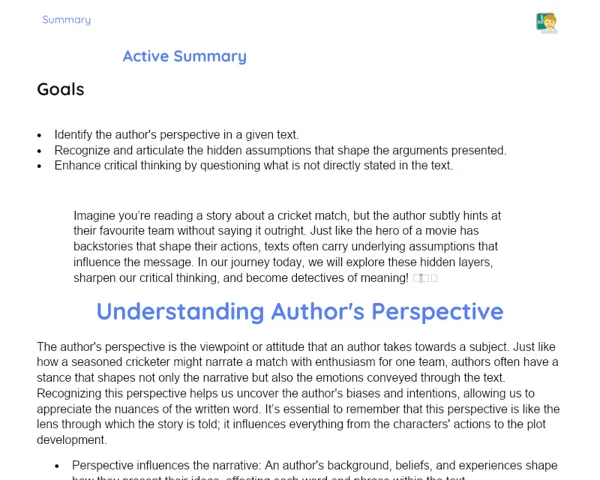Objectives
1. Identify and analyze the key elements of a text in English, including theme, characters, and setting.
2. Develop skills to tackle interpretation questions, leveraging the prior knowledge gained at home.
3. Encourage student interactions, motivating them to share diverse interpretations and viewpoints on the texts they've read.
4. Incorporate specific vocabulary from the text during discussions and various classroom activities.
Contextualization
Did you know that interpreting texts in English is an essential skill, not just for school but also for our everyday lives? Many things we read daily, from user manuals to news articles, emails, and even movie subtitles, are in English. Mastering text interpretation helps us grasp the world around us better and opens doors to fantastic educational and job opportunities. So, let’s journey into the realm of text interpretation together and see how this skill can enhance the way we communicate and make sense of our surroundings!
Important Topics
Theme
The theme of a text is the main topic around which the narrative revolves. Recognizing the theme is crucial for understanding the purpose and meaning of the text. Generally, the theme can be articulated in a single word or phrase that encapsulates the primary idea of the text.
-
Identifying the theme clearly aids in the overall interpretation of the text.
-
Themes may vary from narrative to informative texts, and grasping it is essential for answering interpretation questions.
-
Discussing the theme with peers allows students to see connections between different portions of the text and grasp how these components contribute to the whole.
Main Characters
Main characters are vital to any story, as they propel the plot and engage with the setting and other characters. Understanding these characters involves analyzing their actions, motivations, and growth throughout the text, which significantly aids in interpreting conflicts and resolutions in the story.
-
Identifying and examining the main characters helps in comprehending the relationships and events in the text.
-
Understanding each character's traits and how they influence their actions is crucial for predicting plot developments.
-
Contrasting different main characters can offer valuable insights into the theme and the messages the author intends to convey.
Setting
The setting of a text outlines the physical and emotional backdrop where the action unfolds. Understanding the setting is key to visualizing scenes and grasping its impact on the mood and actions of the characters. It encompasses not just physical descriptions but also cultural, historical, and social elements that add depth to the narrative.
-
Analyzing the setting enables deeper immersion in the story and insight into the characters' motivations.
-
The setting can evolve as the narrative progresses, possibly indicating shifts in the plot.
-
Discussing the setting with classmates can uncover various interpretations and enhance understanding of the text’s intricacies.
Key Terms
-
Text Interpretation: The skill of understanding and analyzing texts, identifying elements such as theme, characters, and setting.
-
Theme: The central subject of a text that organizes the plot and the ensuing discussion.
-
Main Characters: Key individuals in a narrative whose actions and interactions drive the plot.
-
Setting: The physical and emotional context within which the action of a text occurs, essential for comprehension and the atmosphere of a story.
For Reflection
-
How might identifying the theme of a text shape our interpretation of the characters' actions?
-
In what ways can the setting of a story influence a reader's perception of what unfolds?
-
Why is it important to discuss your interpretations with classmates, and how can this enhance your understanding?
Important Conclusions
-
During this lesson, we explored how interpreting texts in English is essential not only in academic settings but also in countless situations in our everyday lives—like understanding manuals, communicating in international environments, and more.
-
We discussed important elements of a text, including theme, main characters, and setting, and how a grasp of these elements can enrich our reading and improve our communication skills.
-
We honed our critical analysis and debating skills, learning to formulate sound arguments based on text interpretation, which is vital both in school and in the workplace.
To Exercise Knowledge
Create a small book or comic that includes a central theme, at least two main characters, and a well-described setting. Once you've completed it, ask a friend or family member to read your work and pose questions about your text to assess their understanding and the clarity of your message.
Challenge
Text Detective Challenge: Select a news article in English. Read through it and try to identify the theme, any hidden main characters (if applicable), and the setting. Then, write a concise summary of the article, highlighting how these elements enhance the understanding of the text.
Study Tips
-
Practice interpreting texts in English daily, whether by reading news articles, watching movies or series with subtitles, or even engaging in online games that involve reading and problem-solving.
-
Maintain a reading journal to jot down the texts you read and your interpretations; this can be incredibly helpful for reviewing and strengthening your text analysis skills.
-
Join reading clubs or online forums dedicated to discussing books in English. This will not only broaden your vocabulary but also expose you to different perspectives on the same texts.


